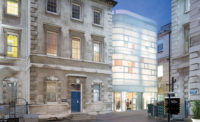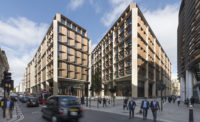Maggie's Centre by Foster + Partners
Manchester, United Kingdom

Foster’s interest in aviation influenced the building’s form and plan.
Photo © Nigel Young

The heated greenhouse and encircling gardens have specific therapeutic purposes, allowing visitors to work with their hands and producing fresh ingredients for the kitchen.
Photo © Nigel Young

Shelves in the “cockpit” greenhouse were arranged to give visitors the sense of being wholly surrounded by plants.
Photo © Nigel Young

Long views draw visitors from the central kitchen toward relaxation spaces with open fires and outdoor terraces that are sheltered from Manchester’s frequent rain.
Photo © Nigel Young

Long views draw visitors from the central kitchen toward relaxation spaces with open fires and outdoor terraces that are sheltered from Manchester’s frequent rain.
Photo © Nigel Young

Clear sight lines from the mezzanine office allow “passive surveillance” of all spaces by the staff.
Photo © Nigel Young

Image courtesy Foster + Partners

Image courtesy Foster + Partners

Image courtesy Foster + Partners









Architects & Firms
According to Angela Daniel, a support specialist at the new drop-in center for cancer patients at Manchester’s Christie hospital, “When people come into this building for the first time, they gasp. Then their shoulders drop and they visibly relax. Quite often, they start crying and ask, ‘Is this really all for me?’ ” Designed by Foster + Partners for Maggie’s, a charity that provides practical and emotional support in purpose-built settings, the center at the Robert Parfett Building is the antithesis of the sterile, strip-lit wards in which many patients receive medical treatment. It yokes the consistent concerns of Foster’s work—for light, landscape, and the beauty of technology—to a unique program developed by the charity’s late founder, Maggie Keswick Jencks, a cancer patient and wife of architecture critic Charles Jencks. Maggie’s buildings should be domestic in scale and character, with every detail considered in terms of its emotional impact, affirming the joy of life without ignoring patients’ fears.
Foster + Partners’ design process began with visits to all 18 existing centers to discover what works best, says project architect Darron Haylock. (These include buildings by architects such as Zaha Hadid, OMA, and Frank Gehry.) The firm’s initial concept sketches, produced before a site was determined, are vague about the building’s formal or material properties but emphasize social interactions and strong visual connections between the building and a garden.
Additional Content:
Jump to credits & specifications
The importance of surrounding greenery led the architects to consider numerous locations before selecting one at the end of a tree-lined street, some distance from the main hospital, where the 5,000-squarefoot center sits within a verdant oasis three times its size. Positioning the building at the northern end of the plot left the largest open space on the sunny southern side, where landscape designer Dan Pearson created a lush cottage garden, mingling shaggy shrubs and ferns, bright clusters of flowers, salad plants in raised beds and espaliered fruit trees. Densely planted strips of garden extend down the building’s long east and west sides, where its low-slung roof forms a canopy over open-sided courts set into the white clapboard facades.
The entrance is on the west side, where visitors are greeted by two sitting rooms with open fireplaces and the kitchen, which is the physical and metaphorical heart of all Maggie’s Centres. Smaller consultation and activity rooms surround the courts on the east side. Separating the open-plan public areas from the cellular private spaces is a north–south spine, which houses bathrooms and study rooms. On top is a mezzanine office, from which staff members overlook all areas.
This spine is flanked by two rows of treelike wood columns that carry the roof. Each sprouts a long beam, which angles downward to the eaves, and two shorter arms angled upward to form a ridge over the mezzanine, framing operable triangular skylights.
To the south, the avenue of structural “trees” extends beyond the envelope, and the building dissolves into the landscape by degrees. A conservatory leads onto a veranda sheltered by an oversailing roof, which merges into a pergola that will be cloaked by climbing plants. At its tip, the roof extends over a wood-framed greenhouse stocked with exotic flora.
This faceted greenhouse is known as the “cockpit,” as if to confirm the aviation influence suggested by the form of the building’s plan (Foster is himself a pilot) and by its distinctive wood trusses and columns, with their filigree lattice of curved chords partly inspired by geodesic airframes of the 1930s. There is “beauty and joy in technology at its pinnacle,” says Foster, and the lattice beams advance the art of timber construction. Each was milled as a single piece from laminated veneer lumber. Columns and beams are joined by gravity connections. “It had to be more refined than a typical public building,” says Haylock: “an essay in timber, without visible metal plates.”
The structure has both the cozy familiarity of a garden trellis and the rational elegance of Gothic tracery. Its quiet sophistication is matched by the close attention to detail that touches every experience of the building, starting at the entrance, where the challenge was to draw in nervous visitors. Large windows and operable ventilation panels give views in, and the sheltered front door is left ajar. Inside, instead of a formal reception area, arrivals pass the open kitchen, where staff greet them.
Interior design reflects the principle that the building should be “homey but not like home,” says Haylock. “It’s comfortable and familiar but also demands respect—like having coffee in your best friend’s mother’s kitchen.” Corridors were eliminated from the design, along with the paraphernalia of medical environments such as signage. Clay-tile floors and sheepskin rugs add warmth and texture. Acoustic soffits dampen reverberations, so quiet conversations remain private.
Much of the furniture was designed by Foster + Partners and has a midcentury Scandinavian style that chimes with the architecture. Seat heights are tuned to the length of time visitors might spend in a particular space. In the “cockpit,” a heavy dining table is set on steel tracks so one person can push it outside in fine weather—one of many small anticipatory gestures that communicate care for the user.
Up to 150 patients visit each day, to take a class, research treatment, or pass the time in sympathetic company. Such informal interactions “might look like we’re just having a chat,” says Daniel, but they disclose important information about a patient’s mobility or mood. She cites a young man who sat at the kitchen counter and asked, “Now that I’m dying, what must I think about?” His question might not have been voiced in a medical setting but could be raised in this calm, intimate environment. “That’s what this building does,” says Daniel. “It helps us do our job.”
CreditsArchitect: Foster + Partners — Norman Foster, principal; Darron Haylock, project
Engineers Foster + Partners (structural, environmental, fire)
Interior designer: Foster + Partners
Consultants Quantity Surveyor: Gardiner & Theobald Landscape Consultant : Dan Pearson Studio Lighting Consultant: Cundall Planning Advisor: IBI Taylor Young Approved Inspector: AIS (Approved Inspector Services) Greenhouse consultant: Fleur de Lys
General contractor: Sir Robert McAlpine
|
SpecificationsStructural System Manufacturer of any structural components unique to this project: Substructures, Foundations and Drainage: Mayo Civils Ltd Structural Timber Frame: Blumer Lehmann AG Timber Main Supporting Structure – Spruce, Ketro Q and Ketro S (Treatment: Impralan UV blocking T300 (inside), T4000 (outside)): Blumer Lehmann AG Pillar – Steel Column, RAL 7044: Blumer Lehmann AG
Exterior Cladding Siberian Larch: Silva Timber Spruce bars with bronze capping (pergola): Blumer Lehmann AG Soffit to the balcony: Medite Exterior grey (aqua grey): Gariff Construction
Roofing Built-up roofing: Timber construction as external wall (SWP 27mm), Timber beam (60x120mm), Insulation Kingspan (120mm), Water Vapour Barrier, OSB 15mm: Blumer Lehmann AG Other: Bullnose – Nordic Bronze, CuSn4 (Sheet thickness: 07.mm/Sheet length: 600mm): Aurubis Chimney – Twin wall flue Poujoulat Ti 250mm id Steel (Senotherm black matt): Dilligence
Windows Wood frame: Solid Oak: Blumer Lehmann AG
Glazing Glass: AA 100 Structural Silicon Glazed: Kawneer AA100 Curtain wall system, RAL 7044: Kawneer Skylights: Frame: AA100 SSG (Structural Silicon Glazed) curtain walling with integrated opening vents, AA100 triangular sloped vents, RAL 7044: Bennett Architectural Aluminium Ltd Other: Capping to Glazing – Accoya timber: Blumer Lehmann
Doors Entrances: Bespoke Raynaers Hi-Finity doors fixed to Kawneer AA100 curtain walling Kawneer 720 bonded glass doors: Bennett Architectural Aluminium Ltd Wood doors: Timber foor: Garriff Construction Oak Timber door (Pickled White Sansin SDF/ Suncool Glazing): Gariff Construction Sliding doors: Bespoke Reynaers, Hi-Finity sliding doors fixed to Kawneer AA100 curtain walling, Kawneer 720 bonded glass doors: Bennett Architectural Aluminium Ltd
Interior Finishes Acoustical ceilings: 18mm Medite perforated panels: Silva Timber Wall coverings: Plasterboard 12.5mm, Dulux Paint (Jasmine White, Matt): Gariff Construction Bathroom cladding – IPS panel, MDF panel with oak veneer coated in white Osmo oil: Gariff Construction Paneling: MDF 18mm (Jasmine White): Gariff Construction Colorrips 410 (Colour 156 Hellbeige): Tisca Tiara Resilient flooring: Staffordshire Blue: Ketley Brick Co Ltd (two sizes: 215mm x 102.5mm x 50mm / 215mm x 102.5mm x 18mm) Sandstone slabs Special interior finishes unique to this project: Steel Balustrade: MAP Engineers Skirting – MDF 15mm, Dulux Paint (Jasmine White, Eggshell): Gariff Construction Ceiling: 18mm Medite perforated panels (Aqua Grey): Gariff ConstructionS
Furnishings Chairs: Cast iron legs: Benchmark AC4 (Cognac): Vilra Stool - Cast Iron legs, Oxide Red, Oak (seat): Benchmark Seoto sofa 3P (Savanna 202): Hida Sangyo Co. Ltd Suita Sofa, Antonio Citterio: Vitra Hiroshima: Maruni Grand Repos and Ottoman, Antonio Citterio: Vitra Walnut top, bronze leg: Foster + Partners design with Molteni Kisaragi armchair (compressed quesrter-sawn, Japanese cedar, Kvadrat, Hallingdal 35 980): Hida Sangyo Co. Ltd Tables: Plywood 25mm – Leather surface (Leather supplier: Lamonti Cuoio S.p.a.): Garriff Construction Cast Iron legs, Oxide Red, Elterwater Stone (Top), Honed (Finishing): Benchmark Foster + Partners design (Oak): Benchmark Other furniture: Galvanised steel (shelf): MAP Engineers Plywod 25mm – Finish: Beech veneer – Upholstery: Kvadrat 4 – Messenger by Maharam (Colour 0048): Gariff Construction Oak, Oxide Red (Foster + Partners design): Benchmark Fire place – Model D313 (steel, senotherm black matt): Trafoart Floor plate – Steel (Black matt): MAP Engineers Walnut, oxide red legs (Foster + Partners design): Benchmark Bathroom Furnishing: Mirror – Clear silver backed float glass mirror with beveled edges, bonded to marine plywood Grab Rail – 1929.20, 32mm diameter grab rail (Satin brushed stainless steel): Trapex Tap – HV1 (Satin brushed stainless steel): Vola Basin – Foster Handrinse Basin #041947 (with overflow): Duravit Basin – Bespoke Corian hand washbasin (polar white): DuPont Trap – A34UK (Satin brushed stainless steel): Vola Toilet Roll Hodler- 1925 Single toilet roll (Satin brushed stainless steel): Trapex Toilet – Architec #019009, wall mounted, 6l flush: Duravit Toilet – Foster toilet #017509, wall mounted, 6l flush: Duravit Grab Rail – 1928 Drop down hinged grab rail (Satin brushed stainless steel): Trapex Flush Plate – Tecesquare, dual-flushing push plate (Satin brushed stainless stell – 240 x 170 x 2mm): Tece Shelves – MDF with oak veneer coated in whit, Osmo oil: Gariff Construction Vanity Top – IPS panel, MDF panel with oak veneer coated in white Osmo oil: Gariff Construction Kitchen Furnishing: Kitchen – Oak finish, Corian top: Benchmark (Foster + Partners design) Freezer – Serie 6, Built-in fridge-freezer KIN86AD30G: Bosh Electric Oven – Serie 8, HBG6764B1B, built in electric single over (black): Bosh
Lighting Interior ambient lighting: Pendant Lighting (black): Caravaggio Flo lighting (oxide red): Lumina, Foster + Partners Fixed LED downlight (warm white 3000K, IP20, RAL 7044): Martini Light Alvar Alto, A 330S pendant light (White painted steel): Artek Light strip – TiMi 352, Linear LED, 3200K, 24V, IP20: KKDC Dimming system or other lighting controls: TiMi 352 (Linear LED, 3200K, 24V, IP20): KKDC (Light Strip)
Conveyance Stairs – Kerto S (Treatment DD-Varnish Wenger, Supremo W3990): Blumer Lehmann AG
Plumbing [putting each product on a separate line, enter in this way: "Product: Manufacturer Name"] KV1M-40: Vola (Tap)
|












